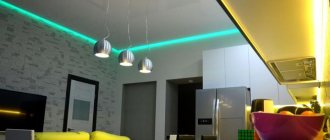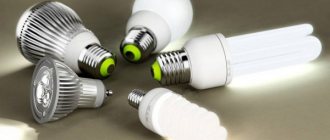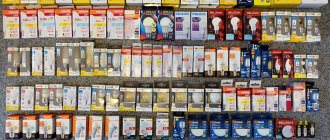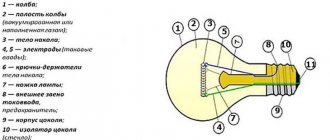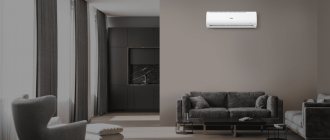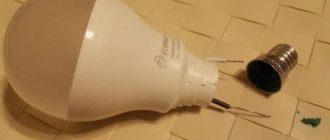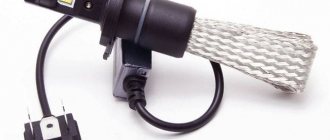Despite the fact that energy-saving technologies are increasingly covering our daily lives, the question of choosing an LED lamp for the home remains one of the most popular search queries on the Internet. Replacing conventional incandescent light bulbs with LED ones has a number of nuances that should be remembered so as not to make a mistake with the choice.
Any housewife knows how bright a 100-watt incandescent lamp is and how much brighter it is than a 60-watt light bulb. But this principle does not work with LEDs; watts no longer play an important role. Another unit of measurement comes to the fore - lumens, which in everyday life means brightness (more correctly, luminous flux).
Comparison table of brightness and power
To draw an analogy in the power and brightness of the glow between the lamps being compared, you should carefully look at the table in the photo.
The table shows why you shouldn’t focus on watts when choosing. A bright LED lamp does not have to consume as many watts as an incandescent light bulb.
If it is difficult to remember the diagram, then there is a simplified version of an approximate calculation of the correspondence between the luminous flux of incandescent and LED lamps, which will help you figure out what power of light bulb to buy for home use:
- To replace a 100-watt incandescent lamp, an LED lamp with 1100 -1300 lumens is suitable.
- For a 75-watt one – approximately 750 lumens.
- For a 60-watt one – about 550-650 lumens.
- For a 40-watt one – about 300-400 lumens.
All the necessary information about power and brightness can be found on the packaging of each LED lamp.
It is worth considering that a regular incandescent lamp spreads light over 360 degrees, and an LED lamp only 180. If you install an LED lamp in a chandelier with shades that do not transmit light well, try to ensure that the light bulb is not entirely “hidden” inside the lampshade, otherwise, most of the light flux will be lost, and twilight will reign in the room, even despite the high brightness.
Type of room and lighting level
- Bedroom, kitchen – 150 Lx/sq.m
- Children's room - 200 Lx/sq.m
- Bathroom, toilet – 50 Lx/sq.m
- General purpose office using computers - 200-300 Lx/sq.m
- Large office with open plan - 400 Lx/sq.m
- Office where drawing work is carried out - 500 Lux/sq.m.
- Conference room – 200 Lx/sq.m
- Escalators, stairs - 50-100 Lux/sq.m
- Hall, corridor – 50-75 Lx/sq.m
- Archive – 75 Lx/sq.m
- Pantry – 50 Lx/sq.m
Power to size ratio
When deciding which lamp to choose for a particular lamp, remember that the higher the power of the lamp, the heavier and larger it is. All LED lamps are equipped with a cooling radiator, which is necessary for high-quality heat removal - otherwise it will overheat and fail faster. The larger the lamp, the larger its radiator, and the material from which it is made largely depends on its size and weight.
For example, light bulbs with aluminum radiators are always somewhat lighter (but also more expensive), while a glass radiator makes them much cheaper, but heavier and bulkier. In addition, glass heat sinks are not used for high-power lamps, as they have limited thermal conductivity - but some are aware of this fact, so the buyer should be wary.
Can LEDs be used with dimmers?
A dimmer is a device that allows you to adjust the intensity of the light. Not all models of LED lamps allow you to connect them to adjustable switches. Therefore, carefully study the packaging and instructions for the product - there must be a mention of joint use. Remember that fluorescent lamps are generally prohibited from being used with dimmers - they simply turn them off.
Types of LED luminaires
Types of socles
When choosing an LED lamp for an apartment, be sure to pay attention to the base.
Most often in everyday life they are used with an E27 socket, which in one feature article was wittily called “well, like an ordinary light bulb.” It is with this base (with a thread and a diameter of 27 mm) that most of the incandescent lamps we are familiar with are produced.
A little less often, but also very often used, is the base - e14, it is also threaded, but of a smaller diameter (14 mm), it is called “minion”. Lamps with such a base usually have a power of 15 to 60 watts, are used in wall and table lamps, and are sometimes used for chandeliers with a large number of arms.
For suspended ceilings, lamps with GX53 and GX70 sockets are often used. Their feature is a pin mount, as well as the small height of the light bulb itself - 28 mm, ideal for built-in lamps. You can also use a GU10 base for mounting ceiling lighting; they are also considered pin-type, but have thickenings at the ends of the contacts.
Lamps with a g9 socket also have a pin mount. Such “microlamps” are widely used for spot lighting in apartments and shops. Lamps with a g4 socket are also used for the same purpose - they are even smaller than g9, the distance between the pins of both is 4 and 9 mm. respectively.
Criterias of choice
It is important to compare your requirements with the characteristics of LED lamps. Before choosing an ice lamp, you need to consider where it will be used. Depending on the location, there are lamps for streets, houses and special purpose premises. According to the purpose of the lamp - to create general and decorative lighting in the room or spot lighting.
LED lamps are distinguished by type of installation: ceiling, wall, floor, table, furniture. Depending on the type of installation, they can be built-in, suspended, overhead, or on a support.
Types of socles
Marking
Housing types
Types of LED lamps
Among the additional functions that may become one of the selection criteria for the buyer are adjusting the intensity and color of the glow, switching modes, built-in speakers, radio, USB port, etc. Before purchasing a lamp, you need to familiarize yourself with the main characteristics.
Power
High lamp power is necessary in rooms with high ceilings, in outdoor areas and in landscape design. For comparison, you can see the table.
| Incandescent lamp power, W | Fluorescent lamp power, W | LED lamp power, W | Luminous flux, Lm |
| 20 | 5-7 | 2-3 | 250 |
| 40 | 10-13 | 4-5 | 400 |
| 60 | 15-16 | 8-10 | 700 |
| 75 | 18-20 | 10-12 | 900 |
| 100 | 25-30 | 12-15 | 1200 |
| 150 | 40-50 | 18-20 | 1800 |
| 200 | 60-80 | 25-30 | 2500 |
To calculate the required power for a home, you need an illumination indicator, which is measured in lux. Thus, we calculate the required light flux per 1 m²: 1 lux = 1 lm x 1 m².
We recommend viewing: Types of Sirius lamps
The algorithm for calculating illumination makes it possible to divide the room into zones where more intense or moderate light is needed. This method helps you save on utilities.
Base
Currently, ice lamps are produced with an E40 or E27 base, provided with IP64 protection, which allows them to be used in all weather conditions.
Types of bases are classified according to application. Threaded is designated by the letter “E”. This type can easily replace an incandescent light bulb. In homes, diode lamps with a standard E14 or E27 socket are used. E14 lamps are called minions.
Types of socles
The size of the base depends on the size of the flask. The GU10 connector has 2 pins with thick ends, where G is the pin type, U indicates the presence of thick ends, and the distance between the pins indicates a digital value. The design of the base corresponds to the starter connectors, which serve as one of the elements of gas-discharge light sources. The mount in such lamps is rotating.
Electrical safety and ease of installation are the main advantages of the pin base.
Lamps with this base are used in reflector ceiling lamps. The GU5.3 and GU9 connector is used for suspended ceilings and has the same advantages as GU10.
LED devices in the shape of a tube have a G13 base. They can replace fluorescent light sources and illuminate large areas and rooms with high ceilings.
The GX53 socket is used in lighting devices that have a built-in function, for finishing furniture and ceilings.
It will be useful to familiarize yourself with: Basic types of bases
Lamp Warranty
Reputable manufacturers provide a warranty on LED devices for at least 2 years. The warranty for LED lamps is on average 6-12 months, for lamps intended for interior use - 1-2 years.
Some manufacturers may not provide a warranty period, in which case the store assumes this obligation. If the store does not fulfill the condition, then the warranty period is automatically set to two years.
Having discovered a malfunction before the expiration of the warranty period, the buyer has the right to demand that the store comply with its rights provided for in Article 18 of Law No. 2300-1. If there is no warranty period, the buyer can make a claim within a period of up to two years.
Featured video: How to extend the life of an LED lamp
The seller has the right to refuse to return money to the buyer or fulfill other obligations if he can prove that the lighting device does not work:
- due to improper transportation;
- due to an accident;
- due to improper treatment;
- due to an attempted repair;
- due to connection to faulty equipment.
Scattering angle
Conventional electric sources illuminate the largest possible area around them, LEDs direct light only in one direction. A diffuser is used to cover a larger area.
Degree of radiation depending on the type of light bulb
Installing LEDs in a plane at different angles allows you to achieve a uniform distribution of light flux. LED bulbs can distribute light at an angle of 60° or 120°.
Life time
LED lamps differ from conventional lamps in their durability, which is why customers love them. Manufacturers usually overestimate the service life.
For example, they often indicate a service life of 5-7 years. However, after 3-4 years the lamps begin to lose brightness. This may be due to voltage drops, which are not taken into account by the manufacturer when calculating service life.
May overestimate other lamp characteristics. For example, they indicate a power of 5 W, but in reality it is 8 W. As a result, electricity consumption increases significantly, and efficiency decreases. If you don’t want to be deceived, purchase light bulbs from trusted manufacturers.
We recommend viewing: What to consider when choosing LED lamps.
Colorful temperature
One of the advantages of LED lamps over competitors is color temperature. Choosing a spectrum of colors makes it possible to create different atmospheres in rooms.
Color temperature is measured in Kelvin. There is a pattern that shows what the shade of white depends on. If the Kelvin value is lower, the light is warmer. The higher the value, the closer the light is to sunlight with a natural, cool tint.
2700K emits a warm light with a reddish-white tint, creating a cozy home and has relaxing properties that provide relaxation and rest.
3000K creates a warm light with a yellow-white tint. Halogen and LED bulbs have such indicators and are suitable for apartments and private houses.
3500 K – daytime white light, which is suitable for offices and public places.
4000 K – cool white light, used in medical institutions, in the subway, etc.
Color temperature spectrum
5000-6000 K - daylight with a white-blue tint, well suited for industrial organizations, factories, greenhouses, etc.
6500 K – cold daylight with a white-lilac tint. Used in warehouses and industrial institutions, for street lighting.
Which LED lamp to choose for home use depends on individual preferences.
The color temperature indicator can be found on the packaging in the list of characteristics. The information is duplicated on the base.
If you don’t know how to choose an LED lamp for an apartment or other room, which shade is more suitable, you can refer to regulatory documents, namely SP 52.13330.2011 “Natural and artificial lighting”, where there are recommendations.
Colorful temperature
Another important characteristic to consider when choosing LED lamps for home use. Color temperature is measured in degrees on the Kelvin scale (K). The lower the number indicated on the packaging, the warmer (yellow) the color of the lamp itself will be.
When choosing a color temperature, a simple rule applies: a warmer color is perceived by a person as cozy and relaxing, while a cooler color helps to concentrate for active activities and work.
- Soft (warm) white - 2700-3500 K - would be appropriate in the living room or bedroom; it should also be used for lamps above the dining table.
- Bright white - 5300 - 6500 K - suitable for a garage, kitchen or bathroom.
- Daylight - 4000 - 5000 K - such lamps are good to use for spot lighting of a dressing table, a place for needlework or reading. They can also be used in the kitchen, hallway and bathroom.
The color temperature of a conventional incandescent lamp is about 2800 K. Therefore, the range from 2400 to 3000 K is considered the most familiar and comfortable for the eyes.
No matter how much marketers advertise their products and talk about their harmlessness, unscrupulous manufacturers still produce low-quality products, so you definitely need to find out why LED lamps are harmful to the human body and how to identify a low-quality light bulb.
Introduction
LED lamps became widely used about 10 years ago. The first models were not very successful - they often burned out and did not provide high-quality lighting. What is their main difference from incandescent lamps?
LED lamps are the most practical and economical
In a classic lamp, a tungsten filament shines, heated to high temperatures. In fact, the glow of the spiral is a “by-product” - almost 95% of the energy is converted into heat and only 2-3 into glow .
LED lamps use a semiconductor that converts electricity into light. The advantages of this technology include:
- Low power consumption. Modern LEDs consume 5-15 watts instead of 70-100, like incandescent lamps.
- They do not produce ultraviolet radiation, which is harmful to the eyes.
- They practically do not heat up and dissipate heat effectively.
- They have a long service life (7-10 years).
The only disadvantage we can highlight is the price - it is significantly higher than for classic lamps. But their cost is constantly falling - today you can buy sets of 4 lamps for 500-700 rubles. Let's consider which diode light bulbs are best suited for the home and how to choose them correctly.
LED table lamps
Despite all the efforts of designers who design hundreds of spotlight options for apartments, ordinary table lamps will not soon go out of everyday use. But the light bulbs themselves in the usual lamps are already being replaced with more modern ones.
To choose the right LED lamp for your work area, let’s remember the recommendations of ophthalmologists. Doctors believe that incandescent lamps with a power of 40-60 watts are best suited for table lighting. This means that the LED equivalent must have a luminous flux in the range of 400-600 lm.
As mentioned above, for the workplace it is better to choose not warm light, but daylight or cold light. If you plan to write a lot using the light of a table lamp, then cold light is also “dispensable”, since a white sheet in such lighting will seem too bright, leading to eye fatigue. So the ideal choice is a natural white (daylight) light lamp.
Scope of application of LED lighting
LED lamps are used for a variety of purposes, for example, for lighting:
- outdoor - roads and sidewalks, building facades, construction sites, parking lots, etc., such lamps have a high degree of protection (IP) from moisture and dust, “vandal-proof” design;
- indoor household and office - serve as a complete replacement for previously used incandescent, halogen and fluorescent lamps, have similar dimensions, base and appearance;
- industrial - high power with high luminous flux and good protection (IP), used in warehouses and production facilities;
- special - phytolamps for growing plants (Grow light), ultraviolet, automotive, etc.
In addition, a large number of lamps with built-in LED light sources and LED spotlights are produced.
LED spotlight ERA Eco Slim 100W 9000 Lm 6500K
Review of popular manufacturers
LED light bulbs are quite expensive, and no one wants to waste money. Therefore, knowledgeable people have long compiled a rating of the most popular and reliable manufacturers of LED lamps.
Do not give in to the temptation and buy lamps made in China in online stores. Such products are often produced in violation of all technological norms and rules, as a result of which Chinese ones fail quite quickly, some even after the first turn on. If funds do not allow you to immediately replace all the light bulbs in the apartment with LED ones, it would be more correct to do this gradually, but to buy products from well-known and trusted companies, rather than cheap analogues made in China.
So, the top three best manufacturers include:
- Philips. Light bulbs from the Dutch brand are considered “the best of the best.” And not only in terms of build quality and materials, but also in terms of product design. The products of this company are reliable, environmentally friendly, and economical, but they have one drawback - their high price. Considering that a good lamp lasts quite a long time, up to 5 years, these costs will ultimately be fully justified. Read the article about the real service life of LED lamps.
- Osram. Austrian-made lamps are also among the best in the world. In terms of their characteristics and advantages, they are not much inferior to Philips products (and in some places they are superior), but the disadvantage is still the same - the high cost of the product.
- Gauss. German brand. The products are manufactured in Russia, judging by the reviews on the Internet, these lamps can safely be put on a par with the products of the best foreign companies. A nice bonus is a beautiful and original design.
In addition to the “best of the best,” you can safely purchase products from a number of other companies whose light bulbs are considered quite reliable and are significantly cheaper:
- Optogan. A Russian company, a worthy competitor to Gauss in all technical parameters.
- Camelion. Despite the fact that they are made in China, they are quite popular on the Russian market and do not have many negative reviews.
- Nichia. Japanese lamps are characterized by users as “nothing special,” but at the same time they are distinguished by good assembly (like all products from Japan) and relatively low cost.
Job resource
When studying how much LED lamps cost, be sure to pay attention to their service life (many manufacturers indicate it on the box). Modern LEDs can operate for 40-50 thousand hours, which is approximately equal to 12-15 years of service. But in reality, most LEDs do not last that long. After 5-7 years of operation, the semiconductor degrades and the quality of the glow decreases significantly (luminous flux, glow temperature). In addition, in most cases, the lamp fails not because the semiconductor has completely expired, but because of electronic failures (power supply and chip control). Therefore, focus not on the resource, but on the warranty period (usually it is 3-5 years).
Be sure to keep the packaging and receipt for the product, and also remember exactly where you bought it, and if the LED fails, you can exchange it for a new one for free.
The radiator in the lamp must be aluminum
And what's the result?
From all of the above, several simple conclusions can be drawn:
- The main characteristics of LED lamps that you need to pay attention to when purchasing are brightness (luminous flux), size and material of the radiator, type of base, color temperature.
- The choice of LED lamp also depends on the purpose of the room in which it will be installed. This is especially true for color temperature and brightness.
- A good LED lamp is almost always expensive, and cheap Chinese analogues are simply a waste of money.
- Before purchasing, it is worth collecting information about each specific manufacturer, the pros and cons of its products.
Happy shopping!
Types of LED lamps
To choose an LED lamp, you need to familiarize yourself with the main classification and key differences between each type.
Standard
Classic models with electricity consumption of 30-40 W, but the average value is about 5-12 W. The devices work for a long time; under certain conditions they can last more than three years. A distinctive feature is that during operation they practically do not emit heat, therefore they do not pose a danger to fusible materials around.
There are no harmful vapors (for example, mercury) inside the glass bulbs of such light bulbs. There is also no fragile filament, so the mechanism will not fail due to shaking. An additional advantage is the variety of shapes, sizes and styles of lamps.
RGB lamps
The abbreviation is formed from the first letters of the three names of colors in English - red, green and blue. Light bulbs with this mark can shine in any shade, which is made up of three main ones (red, green and blue). RGB light bulbs have no other differences. For domestic premises they are used only for decoration - they cannot shine with ordinary light.
Rechargeable
The main difference between the lamps is the presence of a battery. These devices come in two types:
- work from the network, switch to a spare unit in the event of a power outage;
- completely autonomous, they light only from the power supply.
Rechargeable lamps respond well to aggressive climatic conditions, such as sudden temperature changes. They work for an average of three to five years.
LED lamps with remote control
They are considered the most comfortable to use. The remote control operates via infrared or radio signal. An additional control device helps solve several issues - adjust the brightness of the light, turn on/off the circuit remotely, activate some programs (rhythmic or colored flickering).
The main disadvantages include the high cost of light bulbs, installation difficulties and the appearance of another remote control in the room. Otherwise, the lamps are economical, shine brightly, and work for a long time. In addition to the remote control, they use Wi-Fi - special models for smart home technology.
Pros and cons of purchasing this type of light bulbs
Positive and negative aspects can be assessed using the following indicators:
- Price;
- Dimensions;
- Directional light;
- Ripple.
As for the first characteristic, we can say that the cost can be twice as much as for a regular light bulb. This is the main disadvantage of the product. However, it is worth considering that due to energy savings, the cost of the product will pay for itself.
When replacing a light bulb, you need to consider its size. LED dimensions may be larger compared to conventional ones. This may affect the appearance; the light bulb may stick out strongly from the lamp or may not fit there at all.
LED bulbs have a slightly different direction of light, which may be unusual at first. Their side lighting is poor.
The positive thing is that there is no light pulsation. However, not all light bulbs have this phenomenon. You need to purchase a quality product to avoid pulsation that is unpleasant to the eye.
Design
Knowing what an LED lamp consists of, it is much easier to choose the right option on the model market. Each of the ice bulbs has three main elements:
- Mini transformer;
- LED – light source;
- Cooling radiator.
It is the quality of these components that determines the warranty period of each light bulb. In addition to the listed parts, the diffuser, circuit board, power supply and the case itself are also important.
LED lamp device.
1 - Diffuser; 2 - LEDs; 3 - Circuit board; 4 - Radiators; 5 - Power supply; 6 - Housing; 7 - Base; 8 - Capacitor.
LEDs
Lamps of this type always consist of LEDs in different combinations. The LED is a metal base with a medium-sized crystal that acts as a semiconductor. It can dissipate a sufficient amount of energy even at small parameters. The most short-lived option is a light bulb with several white LEDs. Moreover, such a model is ineffective. It is much wiser to take lamps for your home with one very powerful LED or several, but blue ones. It is very important that they are coated with phosphor as this is what produces the bright white light of the bulbs.
Transformer
This element is responsible for voltage conversion. The fact is that the home network almost always has a voltage of 220 V, and the LED only needs 12 V DC. Mini-transformers are considered the most fragile part of a light bulb, as well as the most expensive. A poor quality transformer will inevitably shorten the life of each lamp.
Radiator
Since the crystal constantly heats up, it needs to be cooled. In an LED light bulb, the radiator is responsible for this as an auxiliary element. It is a ribbed structure made of different alloys, which is located between the lamp and the base. Longitudinal slots on the radiator allow air to move freely and provide good heat dissipation.
Usually the radiator is made of aluminum, but in low-power lamps the elements are often made of ceramic or plastic. When the ribbed area is made of metal and the rim is made of cheap materials, the lamp, even with good power, will quickly stop functioning. The fact is that LEDs heat up at maximum glow, and only aluminum is able to cool them down and dissipate heat.
If there are not enough ventilated holes in the radiator, the light bulb will not work for a long time. In cheap light bulbs, manufacturers also allow the longitudinal ribs to be incorrectly positioned. Then, in a horizontal position, the lamp will have poor heat dissipation. This problem can be solved by the cross section of the slots, when the ribs alternate in length and have a certain degree of twist. Such light bulbs can be screwed in both horizontally and vertically, but their price increases.
It is very important to pay attention to the best possible ventilation system. If you install a radiator that is not suitable in size, the light bulb will fail very quickly. Elements that are too large, in turn, increase the dimensions. Some models of LED light sources, with low power, can be so large in size due to radiators that they will not fit into house lamps at all.
It is impossible to visually determine the size and type of radiator, so it is better to focus on the cost of the light bulbs. In the case of a lamp with a frosted bulb, you will not even be able to see whether the LEDs are located correctly on the heat sink element. Therefore, it is easier to reason like this: the more expensive the model, the better the quality of its cooling element.
power unit
The power supply is the weakest link in the design of LED lamps. In most cases, it uses electrolytic type capacitors, which are often of impressive size. Due to manufacturers' savings, the output voltage often loses its stability. For this reason, LED bulbs begin to flicker constantly. In Chinese models this is sometimes noticeable even with the naked eye.
The power factor in the power supply should not be less than 0.9. A low-quality power supply will not be able to withstand even small power surges that occur in electrical networks at home. It is very unpleasant when a light bulb stops working due to a bad unit, but it is not possible to visually evaluate it. Therefore, it is worth paying attention to the fame and status of the manufacturer’s brand itself.
Types of diode light bulbs
The first criterion for dividing is the material of the case:
- Glass (frosted or transparent);
- Aluminum;
- Plastic;
- Ceramics.
By type of base:
- Screw (letter designation – E);
- Pin (letter designation - G).
On the base, in addition to the letter indicating its type, numbers are indicated that indicate for the first type the diameter, measured in millimeters, and for the second type this is the length between the pins.
Thus, the following types of LEDs can be distinguished:
- E14 (bulbs with a smaller diameter base, suitable for some lamps);
- E27 (regular, which are suitable for installation, for example, in chandeliers, where the socket is designed for incandescent light bulbs);
- G4 (can be used, for example, to illuminate pictures).
- GU5.3, G9 (replacement for halogen bulbs);
- GU10 (used for built-in lamps that serve as lighting, as well as in hoods);
This list shows only the main types.
Choices and latest tips
We strongly recommend watching all the videos in the article! It was not in vain that we selected them. They actually answer the topic question. If you really want to understand the choice of lamps and not listen to someone’s advice, but develop your own opinion, then it makes sense to read the entire article, and not some of its individual points. Below are simple aspects that make sense to understand if you do not understand the issue.
- Consider the dimensions of your lampshade and the overall dimensions of the bulb. The length and diameter of the bulb should be indicated on the box. The type of base must match the marking of the cartridge.
- To calculate the time it will take for a light bulb to pay for itself, you need to know its operating time per day, power, price and cost of 1 kW of energy for the home. Multiply the number of days in a month by the average operating time of the lamp. Multiply the result with the power, and then with the cost of 1 kW. The cost of the light bulb is added to the number. The same calculation must be carried out with the previous lamp. The total cost of an LED light bulb must be divided by the difference between the costs of the two lamps. The result will be the number of months for full payback.
- It is also worth choosing LED bulbs because they shine even after short circuits. Network overloads should also not be the reason for the attenuation of a high-quality LED lamp. The fact is that its power acts as a kind of fuse against the load. Therefore, if the light bulb is out of order and the seller does not want to accept it due to failures in your network, continue to insist on your position and demand a replacement.
- Diffusing light is best for the bedroom. A comfortable environment is created by lamps without dark spots. First of all, you need to pay attention to the color temperature of the light bulb, since models with an indicator of up to 3200K are suitable for the bedroom. For lovers of unusual designs and shapes, Gauss light bulbs are suitable.
- In the kitchen, LED light bulbs allow you to quickly carry out the zoning procedure. They illuminate the dining table, set, and stove. It is better to illuminate the eating area with lamps with a soft white tint, and the worktop with cold light from a light bulb.
- LED lamps for the living room must have a radiator. The color temperature is selected depending on the purpose of the light source. It can add a touch of hospitality or speak about the presentability of the home.
- For the desktop you will need fluorescent light bulbs with an indicator of 3200-4500K. Such lamps must have a good power supply. It will be better if you purchase it together with the light bulb or at least check the compatibility in advance. The power factor of the unit must be at least 0.9.
